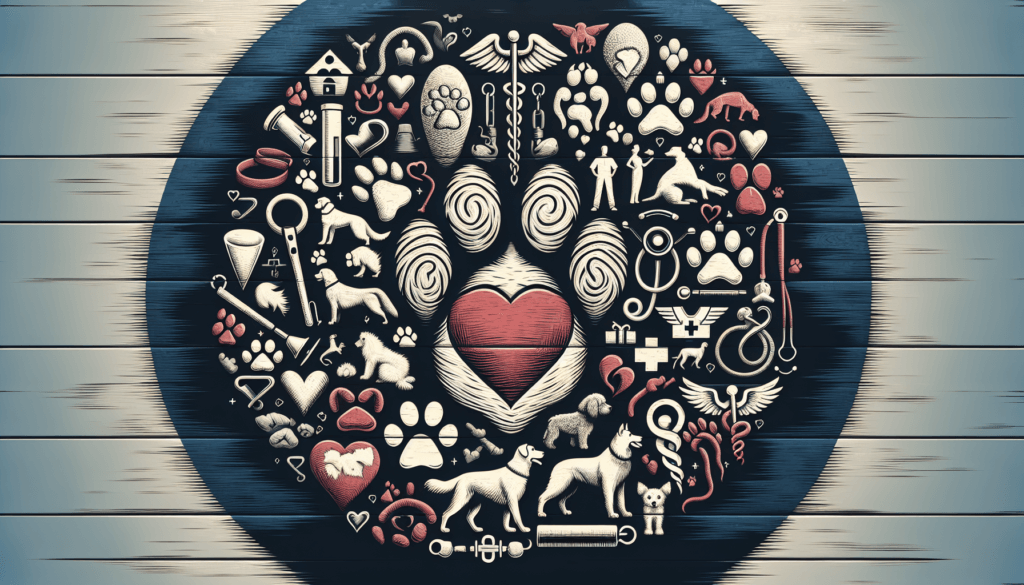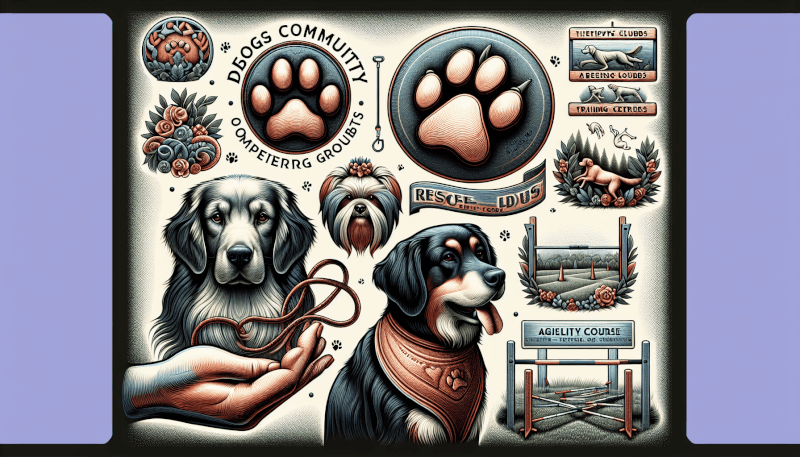Whether you’re a proud dog owner or simply an enthusiast, getting involved in dog community organizations can be a rewarding experience. These organizations play a crucial role in promoting responsible dog ownership, providing resources and support for dog owners, and advocating for the well-being of our furry friends. From breed-specific clubs to rescue groups, each type of organization offers its own unique benefits and brings together like-minded individuals who share a love for dogs. By gaining a better understanding of the different types of dog community organizations, you can find the perfect fit that aligns with your interests and values, and make a positive impact in the dog community.

1. Breed-specific Dog Clubs
1.1 Purpose and Focus
Breed-specific dog clubs are organizations that are dedicated to promoting and preserving specific dog breeds. These clubs focus on providing information, education, and support to breed enthusiasts. Their purpose is to maintain and improve the breed standards, as well as ensure that the breed remains healthy and well-socialized. They act as a valuable resource for individuals who own or are interested in a particular breed, providing guidance on breed-specific training, care, and health issues.
1.2 Activities and Events
Breed-specific dog clubs organize various activities and events to bring together owners and enthusiasts of a particular breed. These may include breed-specific dog shows, obedience trials, agility competitions, and field trials. These events give dog owners the opportunity to showcase their dogs, compete in different categories, and learn from each other. Additionally, these clubs often organize educational seminars, workshops, and social gatherings to further enhance the bond among breed enthusiasts.
1.3 Membership and Benefits
Membership in breed-specific dog clubs is open to anyone who owns or has an interest in the particular breed. By becoming a member, individuals gain access to a wide range of benefits. These may include access to breed-specific publications and newsletters, breeder referrals, mentorship programs, and discounts on dog-related products and services. Additionally, members have the opportunity to network with other like-minded individuals who share the same passion for the breed. Breed-specific dog clubs truly provide a sense of community and support for both new and experienced owners.
2. Kennel Clubs
2.1 Definition and Role
Kennel clubs are organizations that are responsible for the registration and oversight of purebred dogs. They play a vital role in maintaining pedigree records and breed standards. Kennel clubs often serve as the governing body for various dog-related activities, such as dog shows, trials, and competitions. They also provide a wealth of information and resources to dog owners, breeders, and the general public.
2.2 Registration and Pedigree
One of the primary functions of kennel clubs is to register purebred dogs and maintain accurate pedigree records. Through a thorough documentation process, kennel clubs ensure that the lineage of each registered dog is traceable back to its ancestors. This pedigree record is an essential tool for breeders to make informed breeding decisions and maintain breed integrity. Registration with a kennel club is often a requirement for participating in dog shows and other events.
2.3 Dog Shows and Competitions
Kennel clubs are known for organizing and overseeing prestigious dog shows and competitions. These events bring together purebred dogs and their handlers from around the world to compete in various categories such as conformation, obedience, and agility. These shows not only showcase the beauty and skills of different breeds but also provide a platform for breeders to evaluate their dogs against breed standards. Kennel clubs play a crucial role in setting the rules and standards for these events to ensure fair competition and the promotion of responsible dog ownership.
3. Rescue Organizations
3.1 Mission and Goals
Rescue organizations are dedicated to rescuing and rehoming dogs in need. Their mission is to provide a second chance for dogs that have been abandoned, neglected, or surrendered. These organizations prioritize the health, well-being, and happiness of the dogs in their care and work tirelessly to find them loving forever homes. Their overarching goal is to reduce the number of dogs euthanized in shelters and promote responsible pet ownership.
3.2 Adoption Process
Rescue organizations have a well-defined adoption process designed to ensure the best possible match between the dog and prospective adopters. The process usually involves an application, home visit, and interview to assess the suitability of the adopter’s home and lifestyle. The organization may also require reference checks and a meet-and-greet with other pets in the household. Once approved, the adopter pays an adoption fee to help cover the costs of care and veterinary services provided to the dog while in the rescue’s care.
3.3 Volunteer Opportunities
Rescue organizations heavily rely on the support of dedicated volunteers to carry out their important work. There are numerous volunteer opportunities within these organizations, ranging from hands-on tasks such as dog walking, grooming, and socialization to administrative and fundraising roles. Volunteers play a crucial role in providing the much-needed love and attention to dogs awaiting their forever homes. By volunteering, individuals not only make a difference in the lives of these dogs but also experience the joy and fulfillment of giving back to their community.
4. Service Animal Organizations
4.1 Assistance Dogs
Service animal organizations are committed to training and providing assistance dogs to individuals with disabilities or special needs. These highly trained dogs play a crucial role in enhancing independence, mobility, and quality of life for their handlers. They are trained to perform specific tasks tailored to the individual’s needs, such as guiding the visually impaired, alerting to sounds for the hearing impaired, or providing stability and support for individuals with mobility issues.
4.2 Training and Certification
Service animal organizations have rigorous training programs that ensure their dogs are capable of performing the necessary tasks reliably and safely. The training process typically involves basic obedience, specialized task training, and socialization to various environments and situations. Once the dog has completed the training program, they undergo a certification process to ensure they meet the high standards set by the organization. Certification provides legal recognition and protection to the service dog and their handler.
4.3 Partnering with Handlers
Service animal organizations carefully match dogs with handlers based on the individual’s specific needs, lifestyle, and compatibility. The partnership between a service dog and their handler is built on mutual trust, respect, and a deep bond. These organizations provide ongoing support and guidance to ensure the success of the partnership. They may offer follow-up training sessions, access to resources, and a network of fellow service dog handlers for support and camaraderie.

5. Therapy Dog Organizations
5.1 Benefits of Therapy Dogs
Therapy dog organizations focus on training and certifying dogs to provide comfort, companionship, and emotional support to individuals in various settings. The presence of therapy dogs has been shown to have numerous benefits, including reducing stress and anxiety, improving mood, and encouraging social interaction. These dogs visit hospitals, nursing homes, schools, and other facilities to brighten the lives of those they encounter.
5.2 Evaluation and Certification
Therapy dog organizations have evaluation processes to assess a dog’s temperament, behavior, and suitability for therapy work. Dogs with a calm and friendly disposition, as well as excellent obedience skills, are typically well-suited for this role. Once a dog passes the evaluation, they undergo training specific to therapy work. This training includes exposure to different environments, handling by strangers, and responding appropriately to people of all ages and abilities. Certification ensures that therapy dogs meet the standards set by the organization and can confidently interact with a wide range of individuals.
5.3 Facilities and Visits
Therapy dog organizations coordinate visits to various facilities, such as hospitals, nursing homes, and schools, to provide the benefits of animal-assisted therapy. These visits are carefully scheduled and supervised to ensure the safety and well-being of both the dogs and the individuals they interact with. Certified therapy dog teams typically work alongside a handler who is knowledgeable about appropriate interactions and can facilitate meaningful engagements. The presence of therapy dogs brings joy, comfort, and a sense of normalcy to those in need.
6. Working Dog Associations
6.1 Types of Working Dogs
Working dog associations focus on working and sporting breeds that excel in specific tasks such as search and rescue, police and military work, herding, and hunting. These dogs are bred and trained to perform highly skilled jobs that require intelligence, physical agility, and a strong work drive. Working dog associations provide a platform for owners and handlers of these breeds to connect, share knowledge, and further enhance the working abilities of their dogs.
6.2 Training and Skills
Working dog associations often offer training courses and workshops specifically tailored to the needs and abilities of working dogs. These programs focus on obedience, specialized task training, and advanced skills required for the particular tasks that these dogs are trained for. Through structured training, handlers are able to develop a strong bond with their dogs, maximize their potential, and ensure the safety and effectiveness of their work.
6.3 Employment and Jobs
Working dog associations serve as a valuable resource for individuals seeking employment opportunities for their working dogs. These associations often have connections with various organizations such as law enforcement agencies, search and rescue teams, and agricultural enterprises that require the skills of working dogs. They may provide job listings, networking opportunities, and guidance on training and certification requirements. By facilitating these connections, working dog associations contribute to the successful deployment of working dogs in various fields.

7. Dog Sports Clubs
7.1 Agility
Dog sports clubs specializing in agility focus on training dogs and handlers to navigate through obstacle courses with speed and precision. Agility requires teamwork and communication between the dog and handler, as they navigate jumps, tunnels, weave poles, and other agility equipment. These clubs provide training classes, workshops, and competitions to enthusiasts of all skill levels, from beginners to experienced competitors. Participating in agility offers both physical exercise and mental stimulation for dogs, while also strengthening the bond between dogs and their handlers.
7.2 Obedience and Rally
Dog sports clubs dedicated to obedience and rally focus on training dogs to respond to verbal and hand signals with precision and reliability. Obedience emphasizes core commands and behaviors, such as sit, stay, and heel, while rally combines obedience skills with a fun and challenging course. These clubs offer training classes, seminars, and trials to enthusiasts who are interested in competing or simply improving their dog’s obedience skills. Obedience and rally training promote good manners, responsiveness, and a strong bond between dogs and their handlers.
7.3 Flyball and Disc Dog
Flyball and disc dog clubs focus on training dogs to participate in exciting and fast-paced sports. Flyball involves teams of dogs racing over hurdles, triggering a box that releases a ball, which they retrieve and bring back to their handlers. Disc dog, also known as canine frisbee, showcases the athleticism and acrobatic skills of dogs as they catch and retrieve flying discs. These clubs provide training classes, competitions, and demonstrations for enthusiasts who want to enjoy these fun and energetic sports with their dogs.
8. Socialization and Training Clubs
8.1 Puppy Socialization
Socialization is a critical aspect of a dog’s development, particularly during the early stages of their life. Puppy socialization clubs aim to provide a safe and controlled environment for puppies to interact with other dogs and people. These clubs focus on positive reinforcement training methods, ensuring that puppies learn appropriate behaviors, gain confidence, and develop good manners. Puppy socialization clubs often provide guidance to owners on basic training needs and address common puppy challenges such as housebreaking, chewing, and biting.
8.2 Basic Obedience
Basic obedience clubs offer training classes and workshops to teach dogs fundamental commands and behaviors. These clubs focus on promoting good manners, responsiveness, and positive communication between dogs and their handlers. Basic obedience training is essential for ensuring that dogs are well-behaved, safe in various environments, and can respond to important commands such as sit, stay, and come. Moreover, this training enhances the bond and trust between dogs and their owners, setting the foundation for a harmonious relationship.
8.3 Advanced Training
Advanced training clubs cater to dog owners who want to take their dog’s skills to the next level. These clubs offer specialized training programs in areas such as advanced obedience, agility, rally, and specialty skills like scent detection or search and rescue. Training classes and workshops within advanced training clubs are designed to challenge dogs mentally and physically, further developing their abilities and providing a new level of engagement and fulfillment for dogs and handlers alike.

9. Therapy Dog Organizations
9.1 Benefits of Therapy Dogs
Therapy dog organizations focus on training and certifying dogs to provide comfort, companionship, and emotional support to individuals in various settings. The presence of therapy dogs has been shown to have numerous benefits, including reducing stress and anxiety, improving mood, and encouraging social interaction. These dogs visit hospitals, nursing homes, schools, and other facilities to brighten the lives of those they encounter.
9.2 Evaluation and Certification
Therapy dog organizations have evaluation processes to assess a dog’s temperament, behavior, and suitability for therapy work. Dogs with a calm and friendly disposition, as well as excellent obedience skills, are typically well-suited for this role. Once a dog passes the evaluation, they undergo training specific to therapy work. This training includes exposure to different environments, handling by strangers, and responding appropriately to people of all ages and abilities. Certification ensures that therapy dogs meet the standards set by the organization and can confidently interact with a wide range of individuals.
9.3 Facilities and Visits
Therapy dog organizations coordinate visits to various facilities, such as hospitals, nursing homes, and schools, to provide the benefits of animal-assisted therapy. These visits are carefully scheduled and supervised to ensure the safety and well-being of both the dogs and the individuals they interact with. Certified therapy dog teams typically work alongside a handler who is knowledgeable about appropriate interactions and can facilitate meaningful engagements. The presence of therapy dogs brings joy, comfort, and a sense of normalcy to those in need.
10. Support and Advocacy Groups
10.1 Breed-Specific Support
Support and advocacy groups focus on specific dog breeds, providing a platform for breed enthusiasts to connect, share knowledge, and support each other. These groups may offer online forums, social media groups, or face-to-face meetings where individuals can discuss breed-specific topics, share experiences, and seek advice. Breed-specific support groups also play a crucial role in promoting responsible breeding practices, health testing, and education about breed-specific characteristics and needs.
10.2 Advocacy for Legislation
Some support and advocacy groups extend their focus beyond breed-specific matters to advocate for legislation and policies that promote the well-being and rights of all dogs. These groups aim to raise awareness about animal welfare issues, such as puppy mills, dog fighting, and breed-specific legislation. They may engage in lobbying efforts, public campaigns, and educational initiatives to effect positive change and ensure a safe and compassionate world for all dogs.
10.3 Education and Awareness
Support and advocacy groups recognize the importance of education and awareness in promoting responsible dog ownership and fostering a better understanding of dog-related issues. They offer resources, publications, and educational events to disseminate accurate information about breed-specific health concerns, training techniques, and responsible breeding practices. By providing access to reliable information, these groups empower dog owners and the general public to make informed decisions and contribute to the well-being of dogs in their communities.
In conclusion, the world of dog community organizations encompasses a wide range of groups, each with its unique purpose and focus. Whether you are a breed enthusiast, a dog owner looking for activities and companionship for your dog, or someone passionate about making a difference in the lives of dogs and their owners, there is a dog community organization out there for you. By exploring these organizations and getting involved, you can enhance your relationship with your dog, connect with like-minded individuals, and contribute to the well-being of dogs in your community. So go ahead, join a club, offer your support, and embark on a rewarding journey within the vibrant world of dog community organizations.



